Abstract
Ageing is a highly complex process; it involves interactions between numerous biochemical and cellular mechanisms that affect many tissues in an organism. Although work on the biology of ageing is now advancing quickly, this inherent complexity means that information remains highly fragmented. We describe how a new web-based modelling initiative is seeking to integrate data and hypotheses from diverse biological sources.
This is a preview of subscription content, access via your institution
Access options
Subscribe to this journal
Receive 12 print issues and online access
$189.00 per year
only $15.75 per issue
Buy this article
- Purchase on Springer Link
- Instant access to full article PDF
Prices may be subject to local taxes which are calculated during checkout



Similar content being viewed by others
References
Kirkwood, T. B. L. & Austad, S. N. Why do we age? Nature 408, 233–238 (2000).
Kirkwood, T. B. L. Evolution of ageing. Nature 270, 301–304 (1977).
Finch, C. E. & Kirkwood, T. B. L. Chance, Development and Aging (Oxford Univ. Press, New York, 2000).
Herndon, L. A. et al. Stochastic and genetic factors influence tissue-specific decline in ageing C. elegans. Nature 419, 808–814 (2002).
Kirkwood, T. B. L. & Finch, C. E. The old worm turns more slowly. Nature 419, 794–795 (2002).
Kowald, A. & Kirkwood, T. B. L. Mitochondrial mutations, cellular instability and ageing: modelling the population dynamics of mitochondria. Mutat. Res. 295, 93–103 (1993).
Kowald, A. & Kirkwood, T. B. L. A network theory of ageing: the interactions of defective mitochondria, aberrant proteins, free radicals and scavengers in the ageing process. Mutat. Res. 316, 209–236 (1996).
Kirkwood, T. B. L & Kowald, A. Network theory of ageing. Exp. Gerontol. 32, 395–399 (1997).
Sozou, P. D. & Kirkwood, T. B. L. A stochastic network model of cell replicative senescence based on telomere shortening, oxidative stress and somatic mutations in nuclear and mitochondrial DNA. J. Theor. Biol. 213, 573–586 (2001).
Proctor, C. & Kirkwood, T. B. L. Modelling telomere shortening and the role of oxidative stress. Mech. Ageing Dev. 123, 351–363 (2002).
Szilard, L. On the nature of the aging process. Proc. Natl Acad. Sci. USA 45, 35–45 (1959).
Orgel, L. E. The maintenance of the accuracy of protein synthesis and its relevance to ageing. Proc. Natl Acad. Sci. USA 49, 517–521 (1963).
Kacser, H. & Burns, J. A. The control of flux. Symp. Soc. Exp. Biol. 7, 65–104 (1973).
Kacser, H. & Burns, J. A. Molecular democracy: who shares the controls? Biochem. Soc. Trans. 7, 1149–1160 (1979).
Letellier, T, et al. Metabolic control analysis and mitochondrial pathologies. Mol. Cell. Biochem. 184, 409–417 (1998).
Ainscow, E. K. & Brand, M. D. Top-down control analysis of ATP turnover, glycolysis and oxidative phosphorylation in rat hepatocytes. Eur. J. Biochem. 263, 671–685 (1999).
Murphy, M. P. How understanding the control of energy metabolism can help investigation of mitochondrial dysfunction, regulation and pharmacology. Biochem. Biophys. Acta. 1504, 1–11 (2001).
Hofmeyr, J. S. & Westerhoff, H. V. Building the cellular puzzle: control in multi-level reaction networks. J. Theor. Biol. 208, 261–285 (2001).
Orr, W. C. & Sohal, R. Extension of life span by overexpression of superoxide dismutase and catalase in Drosophila melanogaster. Science 263, 1128–1130 (1994).
Jazwinski, S. M. Metabolic mechanisms of yeast ageing. Exp. Gerontol. 35, 671–676 (2000).
Lithgow, G. J. Aging mechanisms from nematodes to mammals. Nutrition 14, 522–524 (1998).
Larsen, P. L. Asking the age-old questions. Nature Genet. 28, 102–104 (2001).
Gems, D. & Partridge, L. Insulin/IGF signalling and ageing: seeing the bigger picture. Curr. Opin. Genet. Dev. 11, 287–292 (2001).
Cournil, A. & Kirkwood, T. B. L. If you would live long, choose your parents well. Trends Genet. 17, 233–235 (2001).
McAdams, H. H. & Arkin, A. Stochastic mechanisms in gene expression. Proc. Natl Acad. Sci. USA 94, 814–819 (1997).
Kowald, A. & Kirkwood, T. B. L. Accumulation of defective mitochondria through delayed degradation of damaged organelles and its possible role in the ageing of post-mitotic and dividing cells. J. Theor. Biol. 202, 145–160 (2000).
Cortopassi, G. A., Shibata, D., Soong N. W. & Arnheim, N. A pattern of accumulation of a somatic deletion of mitochondrial-DNA in aging human tissues. Proc. Natl Acad. Sci. USA 89, 7370–7374 (1992).
Lee, C. M., Pang, C. Y., Hsu, H. S. & Wei, Y. H. Differential accumulation of 4977 bp deletion in mitochondrial DNA of various tissues in human ageing. Biochim. Biophys. Acta. 1226, 37–43 (1994).
von Zglinicki, T., Bürkle, A. & Kirkwood, T. B. L. Stress, DNA damage and ageing — an integrative approach. Exp. Gerontol. 36, 1049–1062 (2001).
Holliday, R., Huschtscha, L. I., Tarrant, G. M. & Kirkwood, T. B. L. Testing the commitment theory of cellular ageing. Science 198, 366–372 (1977).
Smith, J. R. & Whitney, R. G. Intraclonal variation in proliferative potential of human diploid fibroblast cells: stochastic mechanism for cellular aging. Science 207, 82–84 (1980).
Campisi, J. From cells to organisms: can we learn about aging from cells in culture? Exp. Gerontol. 36, 607–618 (2001).
Loeffler, M. et al. Somatic mutation, monoclonality and stochastic models of stem cell organization in the intestinal crypt. J. Theor. Biol. 160, 471–491 (1993).
Martin, K., Kirkwood, T. B. L. & Potten, C. S. Age changes in stem cells of murine small intestinal crypts. Exp. Cell Res. 241, 316–323 (1998).
Martin, K., Potten, C. S., Roberts, S. A. & Kirkwood, T. B. L. Altered stem cell regeneration in irradiated intestinal crypts of senescent mice. J. Cell Sci. 111, 2297–2303 (1998).
Martin, K., Potten, C. S. & Kirkwood, T. B. L. Age-related changes in irradiation-induced apoptosis and expression of p21 and p53 in crypt stem cells of murine intestine. Ann. NY Acad. Sci. 908, 315–318 (2000).
Harbinder, S. et al. Genetically targeted cell disruption in Caenorhabditis elegans. Proc. Natl Acad. Sci. USA 94, 13128–13133 (1997).
Arantes-Oliveira, N., Apfeld, J., Dillin, A. & Kenyon, C. Regulation of life-span by germ-line stem cells in Caenorhabditis elegans. Science 295, 502–505 (2002).
Alliance for Cellular Signaling. Overview of the Alliance for Cellular Signaling. Nature 420, 703–706 (2002).
Wolpert, L. The Unnatural Nature of Science 135–136 (Faber and Faber, London, 1992).
Editorial. Nature 417, 471 (2002).
Medawar, P. B. An Unsolved Problem of Biology (H. K. Lewis, London, 1952).
Harman, D. Aging: a theory based on free radical and radiation chemistry. J. Gerontol. 11, 298–300 (1956).
Williams, G. C. Pleiotropy, natural selection and the evolution of senescence. Evolution 11, 398–411 (1957).
Hayflick, L. & Moorhead, P. S. The serial cultivation of human diploid cell strains. Exp. Cell Res. 25, 585–621 (1961).
Friedman, D. B. & Johnson, T. E. Three mutants that extend both mean and maximum life-span of the nematode, Caenorhabditis elegans, define the age-1 gene. J. Gerontol. 43, B102–B109 (1988).
Kirkwood, T. B. L. & Franceschi, C. Is aging as complex as it would appear? Ann. NY Acad. Sci. 663, 412–417 (1992).
Acknowledgements
The BASIS project is funded by the UK Biotechnology and Biological Sciences Research Council, Medical Research Council and Department of Trade and Industry. Our work is also funded by the BBSRC Science of Ageing initiative.
Author information
Authors and Affiliations
Corresponding author
Related links
Rights and permissions
About this article
Cite this article
Kirkwood, T., Boys, R., Gillespie, C. et al. Towards an e-biology of ageing: integrating theory and data. Nat Rev Mol Cell Biol 4, 243–249 (2003). https://doi.org/10.1038/nrm1051
Issue Date:
DOI: https://doi.org/10.1038/nrm1051
This article is cited by
-
Defining aging
Biology & Philosophy (2020)
-
Feedback between p21 and reactive oxygen production is necessary for cell senescence
Molecular Systems Biology (2010)
-
Iron behaving badly: inappropriate iron chelation as a major contributor to the aetiology of vascular and other progressive inflammatory and degenerative diseases
BMC Medical Genomics (2009)
-
Stochastic modelling for quantitative description of heterogeneous biological systems
Nature Reviews Genetics (2009)
-
Explaining oscillations and variability in the p53-Mdm2 system
BMC Systems Biology (2008)



